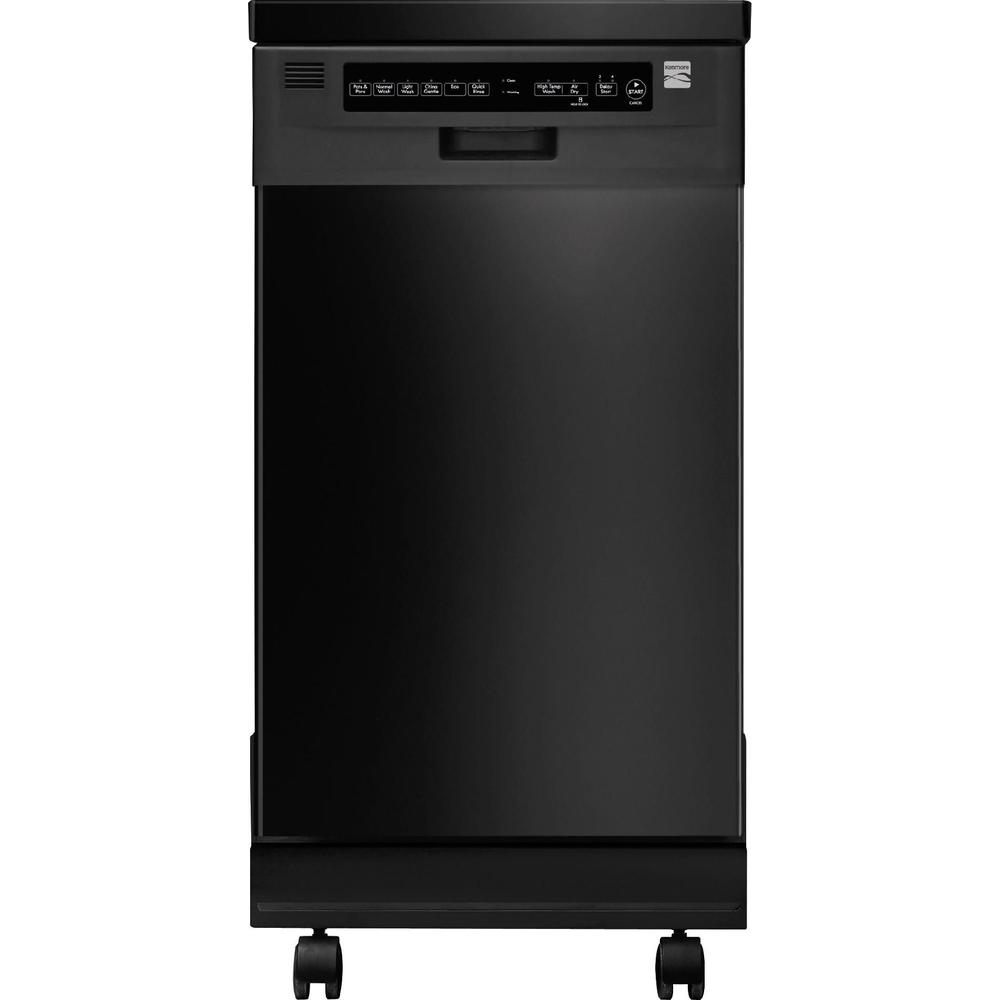Documents: Go to download!
- User Manual - (English, French)
- Owners Manual - English (Warranty) - (English)
- Dishwasher Features
- Operating Instructions
- Dishwasher Dispenser & Detergents
- Care & Cleaning
- Solutions to Common Dishwashing Problems
- Troubleshooting
Table of contents
USER MANUAL Dishwasher
Dishwasher Features
How Your Dishwasher Cleans
Your dishwasher illustrated below, cleans by spraying a mixture of hot, clean water, and detergent against the soiled surfaces of your dishes and tableware.
Each cycle starts with a pre-drain. Next, the dishwasher fills with water to a level even with the heating element. This water is constantly pumped through the rotating spray arm and sprayed on the dishes. Soiled water is pumped out and replaced with clean water during a cycle. The number of water fills depends upon the cycle being used.

Appearance may vary from your model.
Operating Instructions

Appearance may vary from your model.
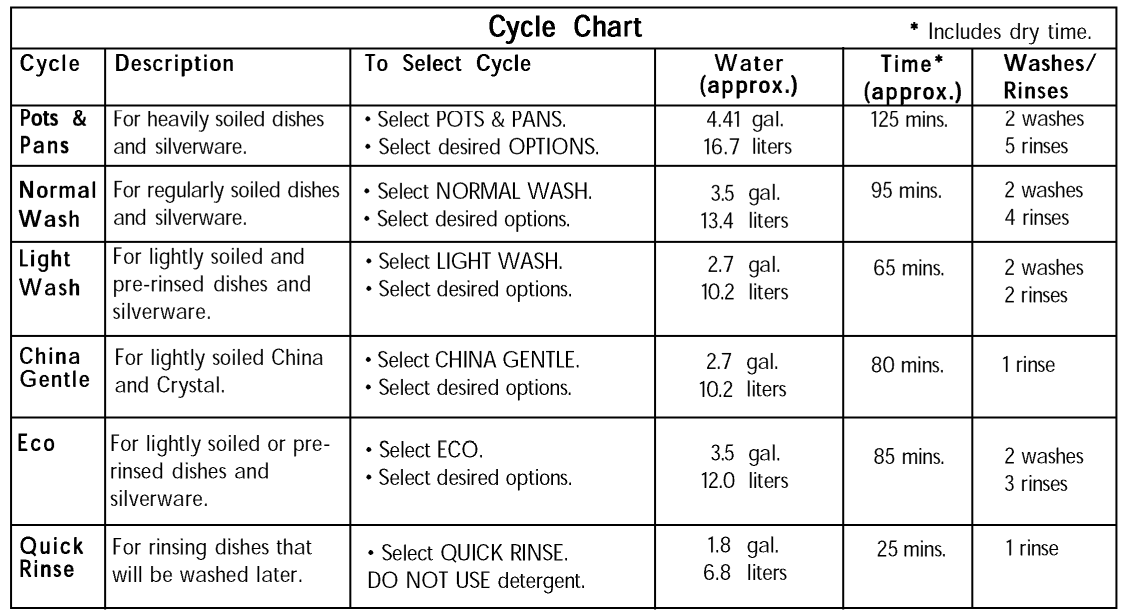
Note: Cycle times are approximate and will vary with options selected. Not all cycles available on all models.
Getting Started
- Check Filter (See Cleaning Filter).
- Load dishwasher (See Preparing and Loading Dishes).
- Add detergent (See Dishwasher Dispenser & Detergents).
- Add rinse aid, if needed (See Rinse Aid).
- Select wash cycle (See Cycle Chart).
- Select desired OPTIONS.
- See Page 12 for instructions on connecting the protable dishwasher.
- Run hot water faucet nearest dishwasher until water is hot. Turn water off.
- To Start, close door to latch.
Dish Preparation
It is not necessary to rinse dishes before putting them into the dishwasher. Just remove large pieces and quantities of food, bones, pits, etc. Empty glasses and cups. It may be necessary to presoak or lightly scour firmly cooked-on or baked-on foods.
Food such as mustard, mayonnaise, vinegar, lemon juice and tomato-based products may cause discoloration of stainless steel and plastics if allowed to sit for a long period of time. Unless the dishwasher is to be operated at once, it is best to rinse off these food soils.
- Load dishes facing the center of the rack so that the water spray from the rotating spray arm can reach soiled surfaces.
- Be sure large items do not block the detergent dispenser, preventing it from opening during the wash cycle.
- To be sure an item is dishwasher safe, read the manufacturer's care instructions.
- If the dishwasher drains into a food disposer, be sure disposer is completely empty before dishwasher is started.
- To save energy, wash full loads.
- For best washing results, load correctly and avoid overloading.
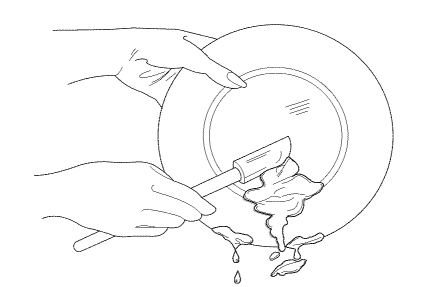
Hi-Temp Wash Option
When HI-TEMP WASH ON option is selected, the dishwasher heats the water in the main wash to approximately 140°F (60°C).
This increase in water temperature helps dishwasher detergent remove food grease and soil from dishes more effectively and aids in drying. HI-TEMP WASH option can be used with all cycles except LIGHT WASH and QUICK RINSE. HI-TEMP WASH is automatically provided when HEAVY WASH cycle is selected.
To turn off the HI-TEMP WASH option, press the pad a second time.
Air Dry Option
The unit defaults to heated dry when it is started with any cycle selected. This drying uses a combination of the heated dry with rinse aid that achieves enhanced drying performance. If you prefer to only have AIR DRY for dishes, you will select AIR DRY and the uit will not energize the heating element. This will reduce energy consumption, but reduce drying performance.
Delay Start
The DELAY START option allows you to automatically delay starting your dishwasher from 2 - 4 hours.
Make cycle selections, press the DELAY START key until the desired delay LED is it, then close the door and the delay time will start.
To cancel the delay and start the cycle before the delay period is over, open the door and press the START/ CANCEL key. Close the door and the cycle will start.
Dishwasher Dispenser & Detergents
Fillingthe Detergent Dispenser
The detergent dispenser has one main wash cup and one prewash cup. The covered cup opens automatically to release detergent.
- Use only fresh automatic dishwashing detergent. Other detergents will cause oversudsing.
- When using automatic dishwashing detergent tabs, place one tab in main wash cup and close.
- Add detergent just before starting cycle.
- Store detergent in a cool, dry location. Moist or caked detergent will not dissolve properly.
How much Detergentto use
The amount of detergent to use depends on the water hardness. Water hardness is measured in grains per gallon. Using too little detergent can result in poor cleaning and hard water filming or spotting. Using too much detergent in soft water can cause a permanent film called etching. Your local water company, water softener company or county extension agent can tell you the water hardness in your area.
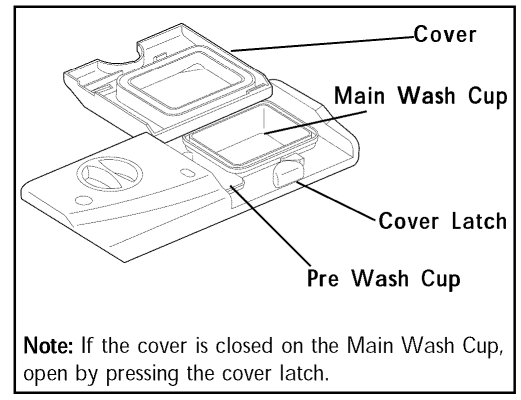
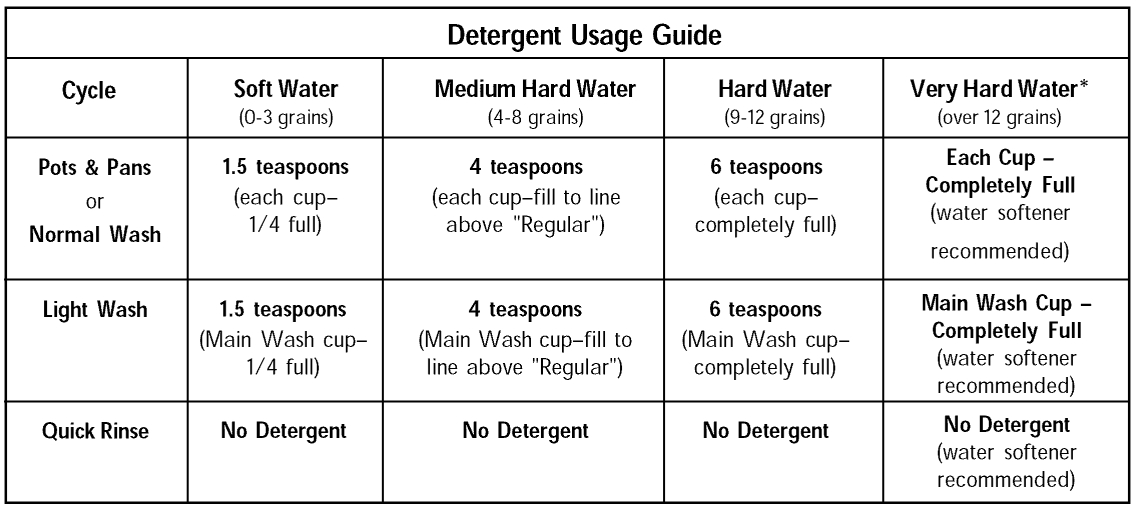
*Note: For very hard water, detergent alone may not be enough. A water softener is recommended to improve water quality and dishwashing performance. Try adding more detergent at the beginning of the main wash portion of the cycle. As a rule, use 1 teaspoon for each grain above 12. Unlatch the door, open slowly and add detergent to the bottom of the tub. Close the door to latch and the dishwasher will continue through the cycle.
RinseAid
Rinse aid greatly improves drying and reduces water spots and filming. Water "sheets" off dishes rather than forming water droplets that cling and leave spots.
A dispenser, located next to the detergent cup, automatically releases a measured amount of rinse aid during the last rinse. If spotting and poor drying are problems, increase the amount of rinse aid dispensed by rotating the dial to a higher number. The dial is located under the dispenser cap. The indicator will be dark when full and will show clear when it is time to refill.
To add liquid rinse aid, turn dispenser cap 1/4 turn counterclockwise and lift out. Pour in rinse aid until liquid touches the indicated fill level. Replace cap.
Do not overfill since this can cause oversudsing. Wipe up any spills with a damp cloth.
The dispenser holds enough for 35 to 140 washes, depending on setting.
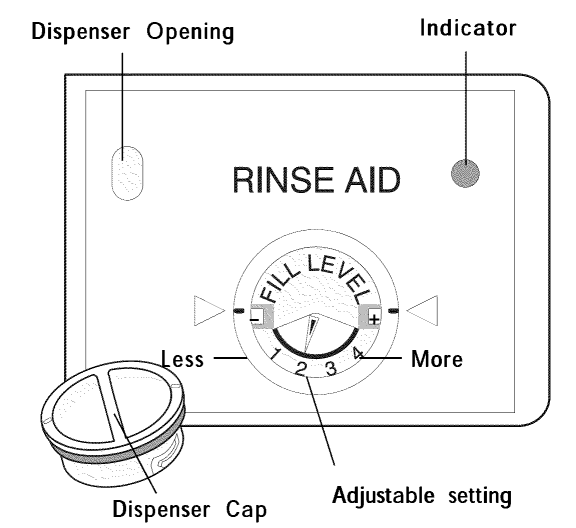
Factors Affecting Performance
Water Pressure
Water pressure should be between 20 and 120 pounds per square inch. Low water pressure occurs most often during periods of high water consumption, such as when laundry or showers are being done. To determine if you have enough water pressure, put a 2 quart container under fully opened hot water faucet nearest the dishwasher. It should fill in less than 14 seconds. Be sure all other faucets are turned off during test.
Water Temperature
Hot water is needed for best dishwashing and drying results. Water entering dishwasher should be 120°F (49°C) to give satisfactory results. To check water temperature entering dishwasher:
- Turn on hot water faucet nearest dishwasher for several minutes to clear cool water from pipes.
- Hold a candy or meat thermometer in stream of water to check the temperature
- If temperature is below 120°F (49°C), have a qualified person raise the hot water heater thermostat setting.
Important: Before starting a cycle, run hot water to clear cool water from pipe.
Not selecting the AIR DRYoption in combination with rinse aid will enhance drying performance. The energy required to use the AIR DRY option costs pennies per cycle. You may choose to select the AIR DRYoption; however you will have items in your dish load that will not be completely dry at the end of the cycle.
Care & Cleaning
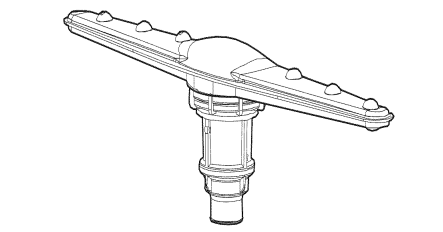
Cleaning the Spray Arm
The spray arm may need to be cleaned to insure that there are no clogs to the spray arm jets and bearings due to hard water chemicals.
To remove spray arm simply hold the spray arm in place and turn the retaining nut clockwise and pull up on the spray arm lifting off the shaft.
To clean the spray arm use warm soapy water using a soft brush to clean the jets and bearings.
To replace the spray arm simply set the spray arm on the shaft, take the retaining nut and turn it counter clockwise till it has locked into place.
Cleaning the Filter
For optimum performance, your dishwasher is equipped with a filter assembly featuring a main filter, cup and fine filter as shown in the drawing above. All food fragments are removed from the dishwasher as water passes through the filter assembly.
Each part of the assembly should be cleaned often to ensure that all food fragments are removed from the dishes. To remove food fragments from the filter assembly, the filters must be removed from the dishwasher. To remove the filters, pull up on the edge of the main filter. Next, rinse the main filter and fine filter under running water. Cleaning with a brush may also be necessary to remove any fragments trapped in the filters. Once cleaning has been completed, simply reassemble the filter as shown in the drawing above. To ensure that the filter is fully seated, please press down on the top of the main filter. Using the dishwasher without a properly installed filter is not recommended as it will reduce the cleaning efficiency and may damage dishware.
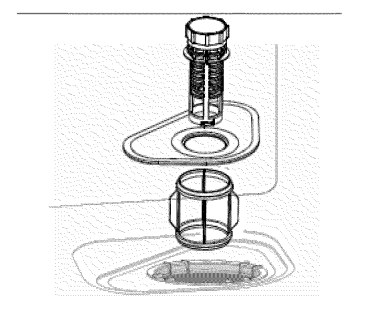
Outside--Occasionally wipe with a mild nonabrasive detergent and water. Rinse and dry.
Inside--The inside of the dishwasher is self-cleaning with normal use.
To clean Stainless Steel wipe with the grain.
NEVER use the products that contain Chlorine Bleach or Citric Acid.
Important: The dishwasher motor is permanently lubricated at the factory and does not need to be oiled.
Care of Drain Air Gap
If a drain air gap was installed for your built-in dishwasher, check to make sure it is clean so the dishwasher will drain properly. A drain air gap is usually mounted on countertop and can be inspected by removing the cover. This is not part of your dishwasher and is not covered by warranty.
Winterizing
A dishwasher left in an unheated place should be protected from freezing. Have a qualified person do the following:
To Disconnect Service:
- Turn off electrical power to the dishwasher at the supply source by removing fuses or tripping circuit breaker.
- Shut off water supply.
- Place a pan under the inlet valve. Disconnect water line from inlet valve and drain into pan.
- Disconnect drain line from pump and drain water into pan.
Note: See Instaflation Instructions for more details on disconnecting and restoring service to your dishwasher.
To Restore Service:
- Reconnect the water, drain, and electrical power supply.
- Turn on water and electrical power supply.
- Fill both detergent cups and run dishwasher through a NORMAL WASH Cycle.
- Check connections to make sure they do not leak.
Note: See Instaflation Instructions for more details on disconnecting and restoring service to your dishwasher.
Solutions to Common Dishwashing Problems
Before calling for service, review this list. It may save you both time and expense. This list includes common experiences that are not the result of defective workmanship or material in your dishwasher.
Dishes not clean--Check pages 4 to 8 for information on correct wash cycle, proper loading, water temperature, water pressure, hard water, amount of detergent, old and ineffective detergent, and dish placement. Io maximize wash performance clean the filter of all large food particles after each wash. To ensure that you clean the filter correctly refer to page 10.
Dishes not drying can be greatly improved by using a rinse aid and hot water. Hot water raises temperature of dishes to speed up drying. When loading, invert cups and bowls so that water can run off. Avoid nestinq of articles. If dishes are not completely dry at end of cycle (which may occur when COOL DRY setting is used), open door, roll out racks, and allow dishes to air dry.
Spotting--Spots form when hard water droplets evaporate leaving a deposit. Low phosphate detergents increase the problem in hard water. To prevent, use hot water and a detergent with a higher level of phosphates (preferably 8.7% or higher), or use more of a low phosphate detergent. I_e sure to use a rinse aid. If water is very hard, it may be necessary to install a water softener. Load glasses and plates so they have minimum contact with racks and pins. Avoid overloading. Spotting will occur where dishes and glasses touch.
Cloudy films and streaking are usually caused by a combination of hard water and an insufficient amount of detergent. Low phosphate detergents are also a factor. To correct, increase amount of detergent, check water temperature and always use a rinse aid. If water is very hard, it may be necessary to install a water softener.
Etched film on glassware is caused by using too much detergent in soft or softened water. This film cannot be removed. It is more likely to occur on soft leaded glass or expensive crystal. An early warning of this condition is a cloudy iridescent appearance on glasses. To prevent, be sure dishwasher is getting a full fill of water. Water should reach base of heating element. If water level is low, have water pressure checked by a plumber. Use less detergent and make sure water temperature is not higher than 150 F (66°C). Underload to assure thorough rinsing. Use the COOL DRY Option.
Chipped dishes and glasses can result from rough handling and improper loading. Do not put glasses in direct coqtact with other items. Place glasses securely against pins.
Crazing of older china and pottery happens when items are subjected to very hot water. Once crazing (fine cracks in the glaze) appears, it cannot be removed. Do not machine wash again or condition may worsen.
Gray-black stains on dishes are caused by manganese in water supply. To correct, install a manganese filtering system into house water supply.
Coffee and tea stains can occur when water contains traces of iron. To avoid stains, rinse cups out immediately after use. Increase amount of detergent and use a rinse aid. Water temperature should be approximately 140°F (60°C). If problem persists, install a water softener with an iron removal unit. TQremove stains, hand wash cups in solution of 1/2 cup (120 ml) bleach and a quart (1 L) of warm water. Rinse thoroughly.
Reddish-brown stains on dishes, glasses and interior are caused by iron in water. To avoid iron stain, increase detergent, use water heated to approximately 140°F (60°C) and a rinse aid. It may be necessary to install a water softener with an iron removal unit. 1-o improve appearance, use a commercial rust and lime scale remover.
Plastic items can lose their shape due to high temperatures of automatic dishwashing. Read labels before washing. Place washable items in top rack away from heating element.
Discoloration of plasticware by some foods, such as tomato sauce, can stain plasticware. If stained, soak item in solution of 1 tablespoon dishwasher detergent and a quart of hot water o[ in a solution of 1/2 cup (120 ml) bleach and a quart (1 L) of hot water.
Fading of patterns and metallic trim is due to many washings, detergent and hot water. Most of today's china is dishwasher safe. Antique, handpainted china, and handpainted pottery should be washed by hand.
Do not place silver next to or touching stainless steel utensils in dishwasher silverware basket. This can cause pitting of stainless steel blades. (Most silver knives have stainless steel blades. Do not let blades touch other stainless steel utensils during wash cycle.)
Tarnish on silver plate occurs when worn down to the base metal and turns a bronze color when exposed to hot water and detergent. Remove bronzing by soaking item in vinegar for 10 minutes or use a silver polish. For permanent protection, have silver replated.
Silver tarnish can be caused by prolonged contact with air or with foods containing sulphur like eggs, mayonnaise, or seafood. Contact with undissolved detergent can also cause tarnish. To prevent this, rinse silver soon after use. Use care not to pour detergent directly onto silver. Remove tarnish with a silver polish.
Discoloration of stainless steel--Food soil can create a film or discoloration. To avoid, rinse stainless items promptly. Food soil films can be removed with a stainless steel cleanser or mild cleanser. Rinse thoroughly.
Pitting of stainless steel is caused by prolonged contact with detergent granules and foods like salt, mayonnaise, fruits, butter or milk. To prevenL rinse soon after use. Do not allow detergent to fall directly onto stainless steel items.
Discoloration of aluminum--Anodized (colored) aluminum cannot withstand machine washing. Resulting loss of color is permanent. Other aluminum may darken when machine washed. To decrease chance of discoloration, do not place aluminum directly beneath detergent dispenser. To brighten darkened items, scour with soap filled steel wool pads. For severely darkened pans, simmer an acidic food or a solution ot Z teaspoons (10 ml) cream of tartar per quart (1 L) of water for 1/2 hour. Scour with soap filled steel wool pad, rinse and dry.
Knife handles become loose when the cement is exposed to very hot water. Test wash a single knife for several weeks. Damaged knives should be professionally re-cemented.
Troubleshooting
Before calling for service, review this list. It may save you both time and expense. This list includes common experiences that are not the result of defective workmanship or material.
Noise problems?
It is normal to hear swishing and pulsating sounds.
These sounds mean that water is circulating through the dishwasher.
It is normal to hear motor sounds before water enters tub. Loud ticking usually means something is hitting wash arm.
See Preparing and Loading Dishes. Vibrating or rattling sounds can mean dishes are touching each other. See Preparing and Loading Dishes.
Operating problems?
Be sure door is firmly closed. It is normal for dishwasher to pause between cycles.
Leaking?
Check for items sticking out of dishwasher that could prevent door from closing and sealing properly. Use only flesh dishwashing detergent to avoid oversudsing. Water coming through door vents? When a dish is added after starting dishwasher, wait a few seconds before latching door. This permits entering cold air to expand slowly inside dishwasher.
Water in tub?
A small amount of water in bottom of tub is normal. It keeps water seal lubricated.
Detergent left in cup?
Detergent may be too old. Discard old detergent.Use fresh detergent. Dishes may not be loaded properly. Be sure items do not protrude from front of bottom rack preventing detergent cup from opening.
Dishes not dry?
Check to see if rinse aid dispenser needs refilling. Hot water temperature may be too low (rain. 120°F 49°C). If COOL DRY option is being used, additional drying time may be required with door open.
See other models: 14543 41783 13229 60519 41072
